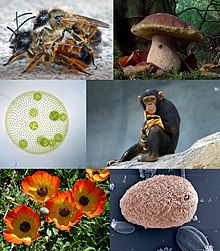Eukaryota
| Eukaryote Temporal range: Rhyacian - Present 2100–0Ma |
|
|---|---|
 |
|
| Eukaryotes and some examples of their diversity | |
| Scientific classification | |
| Domain: |
Eukaryota (Chatton, 1925) Whittaker & Margulis,1978 |
| Supergroups and kingdoms | |
Eukaryotic organisms that cannot be classified under the kingdoms Plantae, Animalia or Fungi are sometimes grouped in the kingdom Protista. |
|
Eukaryotic organisms that cannot be classified under the kingdoms Plantae, Animalia or Fungi are sometimes grouped in the kingdom Protista.
A eukaryote (/juːˈkæri.oʊt/ or /juːˈkæriət/ yoo-KARR-ee-oht or yoo-KARR-ee-ət) is any organism whose cells contain a nucleus and other organelles enclosed within membranes. Eukaryotes belong to the taxon Eukarya or Eukaryota. The defining feature that sets eukaryotic cells apart from prokaryotic cells (Bacteria and Archaea) is that they have membrane-bound organelles, especially the nucleus, which contains the genetic material and is enclosed by the nuclear envelope. The presence of a nucleus gives eukaryotes their name, which comes from the Greek (eu, "well" or "true") and (karyon, "nut" or "kernel"). Eukaryotic cells also contain other membrane-bound organelles such as and the Golgi apparatus. In addition, plants and algae contain chloroplasts. Eukaryotic organisms may be unicellular or multicellular. Only eukaryotes form multicellular organisms consisting of many kinds of tissue made up of different cell types.
...
Wikipedia
